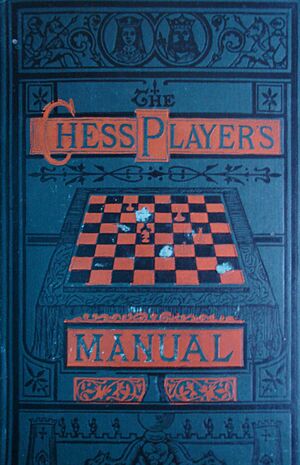S. Lipschütz facts for kids
Quick facts for kids S. Lipschütz |
|
|---|---|
 |
|
| Full name | Samuel or Salomon Lipschütz |
| Born | July 4, 1863 Ungvár, Carpathian Ruthenia, Austria-Hungary |
| Died | November 30, 1905 Hamburg |
Samuel Lipschütz (born July 4, 1863, died November 30, 1905) was a talented chess player and writer. He was born in Ungvár, which was part of Austria-Hungary (now Uzhhorod, Ukraine). Lipschütz became the United States chess champion, holding the title from 1892 to 1894.
Contents
Early Life and Chess Beginnings
Samuel Lipschütz moved to New York City in 1880 when he was seventeen years old. He quickly became well-known in the world of chess.
Joining the Chess Scene
In 1883, he was chosen to play for the New York Chess Club. He played in a match against the Philadelphia Chess Club and won both of his games. This showed how skilled he was becoming.
Winning Club Championships
Lipschütz continued to improve his game. In 1885, he won the championship of the New York Chess Club. This was a big step in his early career.
Major Tournaments and Achievements
Lipschütz played in many important chess tournaments. He often competed against some of the best players in the world.
Playing in London
In 1886, Lipschütz took part in an international tournament held in London. He finished in sixth place. During this tournament, he defeated famous players like Johannes Zukertort and George Henry Mackenzie.
Success at the American Chess Congress
Lipschütz also competed in the Sixth American Chess Congress in New York in 1889. He again finished sixth and was the only American player to win a prize.
Becoming U.S. Chess Champion
One of his biggest achievements was winning the U.S. Chess Championship in 1892. He won a match against Jackson Showalter with a score of seven wins, one loss, and one draw.
Manhattan Chess Club Success
Lipschütz helped the Manhattan Chess Club win the "Staats-Zeitung" challenge cup. He achieved this by winning New York State Chess Association matches and tournaments three times. In 1900, he won the Sexangular Tournament at the Manhattan Chess Club. He finished ahead of strong players like Frank Marshall and Showalter.
Matches Against a World Champion
Lipschütz even played against Emanuel Lasker twice. Lasker later became a World Champion. Lipschütz managed to draw both of his games against Lasker.
Contributions to Chess Literature
Besides playing, Lipschütz also contributed to chess by writing.
Writing Chess Books
He wrote a 122-page appendix for The Chess-Player's Manual by George H. D. Gossip in 1888. This appendix updated the book with new chess opening ideas. Reviewers praised his work for keeping the book current. Chess experts David Hooper and Kenneth Whyld said his appendix helped make it a very important book for chess openings at the time. Lipschütz also edited another book called The Rice Gambit in 1898.
Personal Life and Legacy
Lipschütz was remembered for his personality and his unique chess style.
His Personality and Playing Style
Chess player William Ewart Napier described Lipschütz as a "frail little man." He was known for being polite and having a very long, pointed nose. Chess authors Arthur Bisguier and Andrew Soltis noted that he was a careful attacker. He had some brilliant ideas in chess strategy, but also some less successful ones.
A Clever Chess Idea
For example, in 1889, he came up with a new move in the Ruy Lopez chess opening. This move was 1.e4 e5 2.Nf3 Nc6 3.Bb5 d6 4.Bxc6+ bxc6 5.d4 f6. Even Wilhelm Steinitz, a former World Champion, praised this as an "excellent and novel idea."
Health Challenges and Final Years
Lipschütz suffered from tuberculosis, a serious illness. Because of his health, he often left New York to stay in places with better climates. He lived in Santa Fe (1893), Los Angeles (1893–95), and Florida (1904). In 1904, he traveled to Hamburg for medical treatment. He had several operations but sadly did not recover.
See also
- List of Jewish chess players


